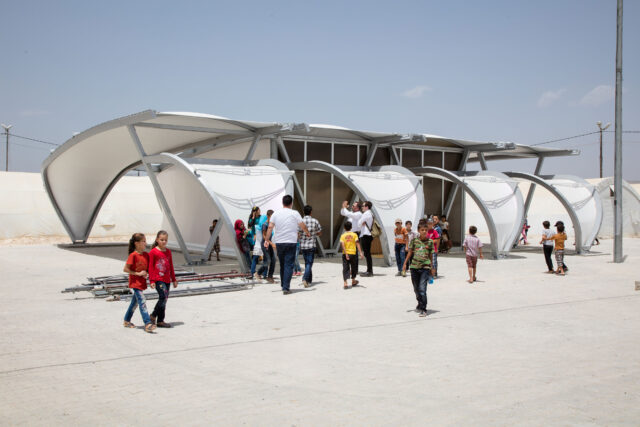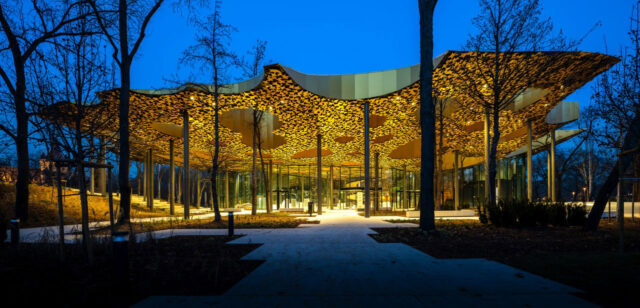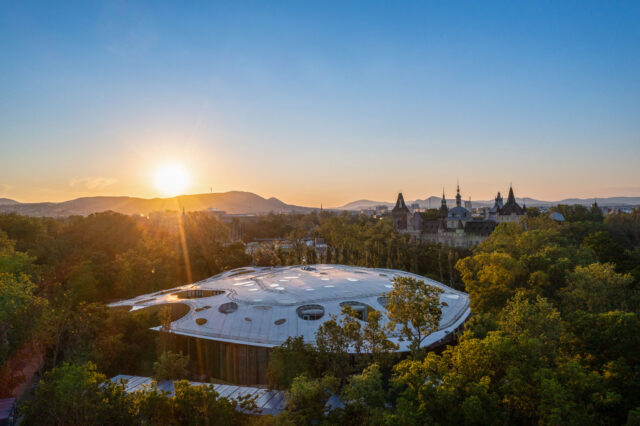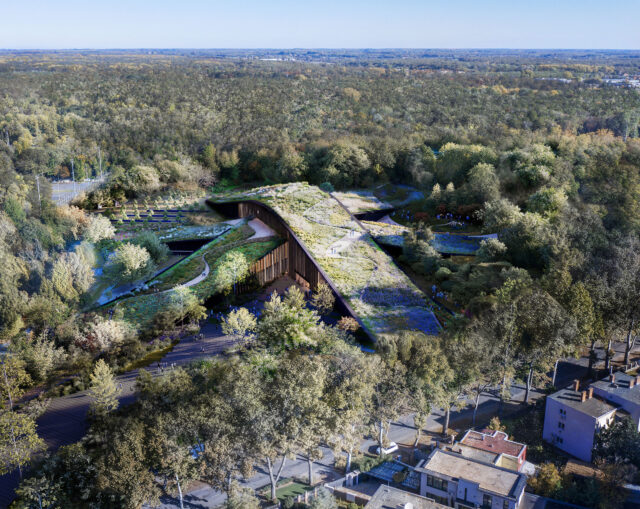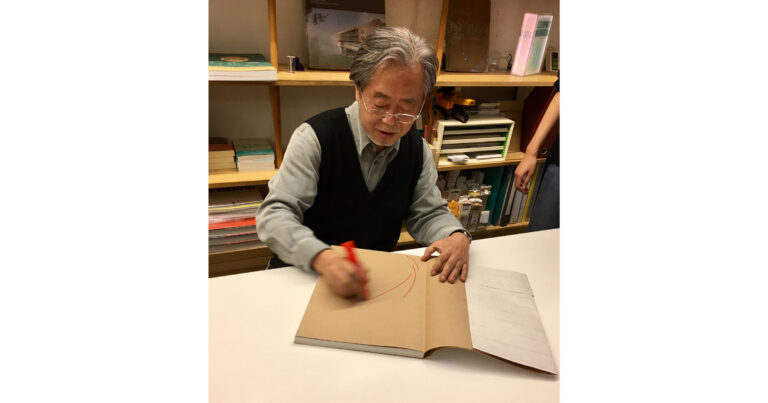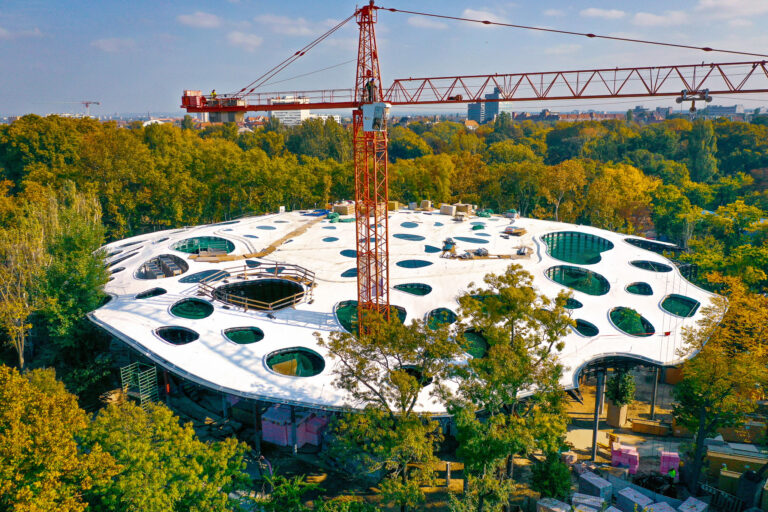
SHARE 藤本壮介による、ハンガリー・ブダペストの音楽施設「ハンガリー音楽の家(House of Hungarian Music)」の現場写真。2021年末の一般公開向け建設が進められる



藤本壮介による、ハンガリー・ブダペストの音楽施設「ハンガリー音楽の家(House of Hungarian Music)」の現場写真です。2021年末の一般公開向け建設が進められています。
以下、プレスリリーステキストの抜粋です
ハンガリーの首都ブダペストでは、ヨーロッパ最大の都市文化開発プログラム「リゲット・ブダペスト・プロジェクト」の一環として、日本の藤本壮介が設計した「ハンガリー音楽の家(House of Hungarian Music)」が建設されています。
この建物は、有機的な起伏のある屋根の構造が目を引きますが、その特徴は広いガラスの壁と穴の開いたキャノピーです。同時に、その優美さと透明な表面のおかげで、それを包む公園と調和し溶け込んでいます。
この新しい施設は、音楽の歴史に関するインタラクティブな展示会、コンサート、エキサイティングな音楽教育ワークショップなどの幅広いイベントを通じて、訪問者に無数の音楽体験をもたらす複合的な音楽伝授の世界初の施設として運営されます。2019年には、この建物はインターナショナル・プロパティ・アワードでヨーロッパのベスト・パブリック・ビルディングに選ばれ、2020年のミュージック・シティズ・アワードでは、不動産開発における音楽の世界的なベスト・ユースの称号を獲得しました。
建物は構造的に完成し、2021年末に一般公開される予定です。CNNと世界建築協会は、ザハ・ハディド、レム・コールハース、レンゾ・ピアノなどのスター建築家の作品と並んで、2021年に最も期待される建築物の1つに「ハンガリー音楽の家」を選びました。
・
リゲット・ブダペスト・プロジェクトは、現在ヨーロッパで最も重要な文化開発であり、ハンガリー最大規模の公園やランドスケープ建築プロジェクトと、ミレニアム以来の規模の施設の開発を組み合わせたものです。リゲット・ブダペスト・プロジェクトの一環である「ハンガリー音楽の家」は、ブダペストの最も重要な観光スポットの一つである英雄広場の近くに、かつてのオフィス街の跡地に建設されています。設計者の藤本壮介は、ユニークで刺激的で有機的な建物を作り上げました。彼のデザインは、国際コンペに応募された168のプロジェクトの中から、ハンガリー人と国際的な審査員によって選ばれました。
藤本壮介のヴィジョン
藤本は「ハンガリー音楽の家」の国際コンペに応募するにあたり、自然環境と建築環境の境界をなくし、自然と音の調和を図るプロジェクトを構想しました。デザインの特徴である浮かぶ屋根は、音の振動を視覚的に表現した「波」から着想を得ています。
開放感と透明感を意識して、建物の側壁をガラスにし、屋根を穴の開いた構造によって採光できる空間とし、木の葉のように建物の内部に光を取り入れるようにしました。彼はまた、ブダペストのリストアカデミーの有名な分離主義者の建物や、ハンガリーの音楽と音楽教育の国際的に有名な伝統からもインスピレーションを得ています。
「世界初の公共公園のひとつで仕事をするというのは、信じられないほど刺激的なことです。リゲット・ブダペスト・プロジェクト、そしてその中にあるハンガリー音楽の家は、まさに象徴的な開発プロジェクトであり、緑と建築環境の間に並外れた調和を生み出したことから、将来の都市開発者のお手本になるかもしれません。」
と藤本壮壮介はそのヴィジョンについて語っています。
以下の写真はクリックで拡大します



















こちらは、藤本のコメント(日本語)も収録された、計画案のCGと現場の様子を収録した動画。
以下、リリーステキストです。
Sou Fujimoto’s award-winning House of Hungarian Music is structurally ready
One of the most exciting contemporary buildings in the world is near to completion
The House of Hungarian Music, designed by Japanese starchitect Sou Fujimoto, is being built in the Hungarian capital as part of the Liget Budapest Project, Europe’s largest urban cultural development programme. The building cannot but draw the eye with its organically undulating roof structure distinguished by its extensive glass walls and its canopy perforated with holes. At the same time, thanks to its gracefulness and transparent surfaces, it harmoniously blends in with the park that embraces it. The new institution will operate as the world’s first facility of complex musical initiation bringing countless musical experiences to visitors through its wide range of events: interactive exhibitions on musical history, concerts and exciting music education workshops. In 2019 the building was selected as Europe’s best public building at the International Property Awards, while at the 2020 Music Cities Award it won the title of the World’s Best Use of Music in Property Development. The building has been completed structurally and it is anticipated to open its doors to the public at the end of 2021. CNN and the World Architecture Community have chosen the House of Hungarian Music as one of the most anticipated buildings in 2021, alongside works by starchitects such as Zaha Hadid, Rem Koolhaas and Renzo Piano.
The Liget Budapest Project is currently Europe’s most significant cultural development, which combines Hungary’s largest-scale park and landscape architecture project with the development of institutions not seen on a scale since the days of the millennium. The House of Hungarian Music, a development forming part of the Liget Budapest Project is being constructed near Heroes’ Square, one of Budapest’s most important attractions, on the site of a formerly demolished office block. The designer, Sou Fujimoto, has created a unique, inspiring and organic building. His design was selected by Hungarian and international jurors from among 168 projects submitted to an international competition.
Sou Fujimoto’s vision
When entering the international competition for the House of Hungarian Music, Fujimoto envisioned a project in which the boundary between the natural and the built environments is dissolved, and harmony is struck between the nature of sound and the sounds of nature. The signature feature of the design, the floating roof, was inspired by the visual representation of the vibration of sound: the wave. In the spirit of openness and transparency, Fujimoto designed the side walls of the building to be made of glass and the perforated structure of the roof articulated by lightwells to let light into the interior of the building much like the foliage of trees. He also drew inspiration from the famed Secessionist building of the Liszt Academy in Budapest and, not least, by the internationally renowned tradition of Hungarian music and music education.
“It is incredibly inspiring to work in one of the world’s first public parks, and the task of designing the building was especially exciting since we not only created an edifice but also brought the park experience into the building. The Liget Budapest Project, and within it the House of Hungarian Music, are a truly emblematic development project, which might serve as an example for future urban developers since it managed to create exceptional harmony between the green and the built-up environments.” – noted Sou Fujimoto about his vision.
Unique architectural solutions
One of the features facilitating the implementation of Fujimoto’s vision is the building’s glass wall, which lends it gracefulness, transparency and individuality. The unique appearance of the House of Hungarian Music is coupled with special engineering solutions: the glass wall of the facade consists of 94 custom-manufactured heat-insulated panels, which are close to 12 metres high in some parts of the building.
Another iconic feature of the design is its organic roof structure: Fujimoto’s special floating roof was inspired by the form of soundwaves. The playfully undulating canopy of varying thickness stays below the level of the foliage, ensuring that the building harmoniously blends in with the environment.
“Underpinning the spectacular and unmistakable sight of the House of Hungarian Music is a host of design and engineering solutions unprecedented in Hungary. There are no right angles in the roof structure, almost no two elements that are the same. It is all unique and the surface is punctured by close to 100 individually designed holes for the trees of the park to emerge through; moreover, one of the innovative solutions was also installed in these openings: the lightwells begin here, which channel the light right down to the lowest levels, thus helping to illuminate the interiors and create a unique ambiance.” – said Sou Fujimoto.
Environmental awareness and sustainability
Environmental awareness has been of paramount importance throughout the construction of the House of Hungarian Music. Special emphasis was accorded to renewable energy and the use of special heating and cooling systems already in the planning phase of the project. One hundred and twenty heat pumps were installed 100 metres underground in a small area of the City Park, called Nagyrét, next to the building to provide renewable geothermic energy. Another economical and extraordinarily innovative solution is the telecooling system. The building of the House of Hungarian Music as well as its construction were rated as exemplary from an environmental perspective by BREEAM, the world’s leading international sustainability assessment method.
Recognition from both the architectural and the music profession
The remarkable building of the House of Hungarian Music drew the attention of the international architectural community. In 2019 it was selected as the best public service architecture project in Europe at the prestigious International Property Awards competition in London, one of the largest-scale, most prestigious and widely acclaimed recognitions of the property sector launched 27 years ago. Then, in 2020, it won the award for the world’s best development with a musical theme in the “Best Use Of Music In Property Development/Real Estate” category at the American Music Cities Awards, a prominent series of events organised by the most important international players in the music industry with the aim of fostering the economic, social and cultural development of cities through the medium of music. The best initiatives in music were evaluated in nine categories. The House of Hungarian Music was chosen among the top three by a jury of ten international experts as the only European project and won the main prize beating two US developments.
The content of the House of Hungarian Music
The unique appearance of the House of Hungarian Music is matched by a special interior structure. The institution’s complex musical profile and programmes are reflected by the three-level layout: the level below ground will be home to exhibitions – permanent and temporary – and a remarkable sound dome; the park level is devoted to the performing arts: live events will be held in the concert halls and the open-air stage alike, while the terrace near the City Park Lake will be a place for recreation; while the level above it will house an archive of Hungarian pop music, serving as a source of quiet immersion in music and education, and the workshops to be held in the music education rooms will initiate young visitors into the complex musical experience awaiting them at the exhibitions and performances.
The House of Hungarian Music will take this rich musical tradition closer to domestic and foreign visitors with its interactive exhibitions utilising 21st-century technology, music education workshops, musical events and those themed on music as well as with its open-air concerts evoking the atmosphere of the musical pavilions of the past. A new, long-awaited institution will be established in the City Park, whose mission is to take music – perhaps the branch of Hungarian art that is best known and most recognized in the world – to the general public.
“The House of Hungarian Music will be unique in that it will accommodate the triad of exhibitions, live music and music education in one venue. It will guide visitors through the world of music thanks to a diverse range of events: the underground level of the building will be devoted to exhibitions, including a permanent show on the history of music, which will take visitors along a journey through the development of music using interactive and spectacular technical solutions.” – said András Batta, the director of the House of Hungarian Music and former president of the Liszt Academy.
On the level below ground, a memorable experience will be provided not only by the temporary exhibitions but also by the sound dome, a special hemispherical cupola in which diverse ‘sound spaces’ will be created with unique audio and projection technologies. The ground floor will house concert halls and an open-air stage, where fledgling musical formations will be given an opportunity to show their talent besides established performers. The first floor will be the venue for music education and a digital library. It will be home to an experience-based information centre with its comprehensive range of events for school groups and groups of children making it indispensable in the education of both classical and popular music.
“The House of Hungarian Music will also take on an educational role with the development of the music education concept and events being the task of a separate team of experts. Something is turned into an experience if people can make what they can see, hear, touch and feel their own, if they can store all this and recall it later. It is therefore especially important that everything that visitors encounter at our exhibitions can be stored as real experiences among their memories.” – stressed András Batta.

